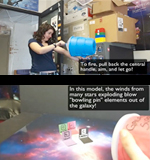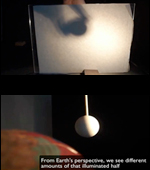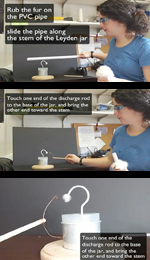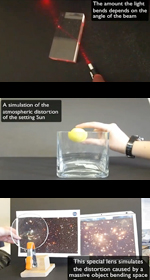


- MAKE YOUR OWN EXHIBIT
- WATCH A VIDEO
- READ A BLOG
- TACTILE & BRAILLE HTE
- AMERICAN SPACES
- PIN SOME IMAGES
- SHARE WITH A FRIEND

Activities.
The Here, There, and Everywhere team has developed an activity kit that educators, volunteers, or docents can use to interact with families or students visiting the exhibit or posters. It's full of table-top demonstrations and activities that, when facilitated, allow small groups of exhibit visitors to explore some of the HTE concepts in a hands-on way. The kit will be shipped to venues on the HTE tour, and members of the Science Education Department at the Smithsonian Astrophysical Observatory are available to conduct webinar/phone trainings for host-site staff. For those who are using only the posters, please feel free to adapt the activities to suit your needs and resources.
HTE Activity Kit Part List - If you'd like to create your own HTE activity kit, here are a few ideas for the materials you might need, a relative price, and one example of where you might purchase them. These materials are available at a variety of retailers.
HTE Activity Kit Contents - This is an illustrated guide to the contents of the HTE Activity.
Request materials for the HTE exhibit.
HTE Activity Guide - This guide contains background and instructions for interpreting and facilitating the activities. Activities include:

- Activity 1 - Thar She Blows!
- Core concept: Wind has a direction and a speed Demonstration Videos: Comet with 2 tails | Using the AirZooka
- Activity 2 - Galactic-wind Bowling!
- Core concept: Galactic winds created by the explosion of a supernova can "blow" particles out of a galaxy. This activity uses a mini air cannon to simulate galactic winds interacting with elements in a supernova. Demonstration Video: Galactic bowling

- Activity 1 - Shifty Shadow Shapes!
- Core concept: The shape of a shadow can change given the orientation of the light or the object blocking the light. This activity explores shadows cast by various shaped objects and those cast by light sources at different angles.Demonstration Video: Blocks
- Activity 2 - Phases, Eclipses, and Shadows, Oh My!
- Core concept: Phases of the moon, condition needed for lunar and solar eclipses. These activities explore shadows in space.Demonstration Videos: Eclipses | Moon phases

- Activity 1 - Leyden Jars and Static Electricity
- Core concept: Positive and negative electric charges can be separated to build up a high voltage, and this voltage can be discharged when the conditions are right. This activity will use Leyden jars to safely explore charge separation and electrical discharge. Demonstration Video: Leyden jar
- Activity 2 - Plasma Ball
- Core concept: Electricity flows from high voltage to low voltage via the most convenient path.
- Activity 3 - Hand Held Generator
- Core concept: When a coil of wire is spun around a magnet, the magnet produces an electric current in the wire. This activity will use a hand generator to explore how rotating magnets can generate an electric potential, or voltage, which produces a current in a wire.

- Activity - Glowing Atoms
- Core concept: Collision between particles can produce light.

- Activity 1 - Playing With Bending Light
- Core concept: As a light ray passes from one transparent medium (such as air, glass, plexi, or water) into another its direction changes. Demonstration Video: Laser through acrylic block
- Activity 2 - Flattening the Sun
- Core concept: Objects look different when viewed through a medium that bends the direction of light rays passing through. The atmosphere can alter the Sun's appearance at sunset. This activity encourages visitors to explore this process themselves using a ball and a square vase. Demonstration Video: Sunset simulation
- Activity 3 - Looking Through a "Black Hole Gravity Lens"
- Core concept: A massive object such as a black hole bends space, and so bends the path of light that comes near it. A black hole distorting space acts as a lens.Demonstration Video: Gravitational lensing

- Activity - Bow Waves
- Core concept: A bow wave is a v-shaped wall of water formed in front of a boat moving faster than the surrounding waves. Demonstration Video: Bow waves
SpaceMath@NASA
SpaceMath@NASA introduces students to the use of mathematics in today's scientific discoveries. Through press releases and articles, Space Math explores how many kinds of mathematics skills come together in exploring the Universe. If you have a math club, the following problems might be fun for them to try in connection with the HTE exhibit:

- Activity 1 - The Crab Nebula - Exploring a pulsar up close! (problem #398)
- Core concept: Students work with a photograph to determine its scale and the time taken by light and matter to reach a specified distance.
[Grade: 6-8 | Topics: Scale drawings; unit conversion; distance = speed x time]
(PDF) [Press Release]

- Activity 2 - The Hand of Chandra (problem #234)
- Core concept: Students use an image from the Chandra Observatory to measure a pulsar ejecting a cloud of gas.
[Grade: 6-8 | Topics: Scientific Notation; proportions; angle measure]
(PDF) [Press Release]

- Activity 3 - Chandra Observatory Sees the Atmosphere of a Neutron Star (problem #283)
- Core concept: Students determine the mass of the carbon atmosphere of the neutron star Cas-A.
[Grade: 8-10 | Topics: Volume of spherical shell; mass = density x volume]
(PDF) [Press Release]

- Activity 4 - Chandra Studies an Expanding Supernova Shell (problem #314)
- Core concept: Using a millimeter ruler and a sequence of images of a gaseous shell between 2000 and 2005, students calculate the speed of the material ejected by Supernova 1987A.
[Grade: 6-9 | Topics: Measuring; Metric Units; speed=distance/time]
(PDF) [Press Release]

- Activity 5 - Chandra Spies the Longest Sound Wave in the Universe (problem #289)
- Core concept: Students use an image of sound waves produced by a massive black hole to determine wavelength, and comparisons with musical scale to find how many octaves this sound wave is below the wavelength of middle-C.
[Grade: 6-8 | Topics: metric measurement; scaling; Scientific Notation; exponents]
(PDF) [Press Release]

- Activity 6 - Giant Gas Cloud in System NGC 6240 (problem #511)
- Core concept: Students use scientific notation and volume of sphere to estimate the density of the gas cloud, and the number of hydrogen atoms per cubic meter.
[Grade: 8-10 | Topics:Volume of a sphere; scientific notation; unit conversion ]
(PDF) [Press Release]
More information at http://spacemath.gsfc.nasa.gov

"Here, There, & Everywhere" (HTE) is supported by the National Aeronautics and Space Administration under grant NNX11AH28G issued through the Science Mission Directorate.
HTE was developed by the Chandra X-ray Center, at the Smithsonian Astrophysical Observatory, in Cambridge, MA.
Email: cxcpub@cfa.harvard.edu | Phone: 617.496.7941
Follow us: #HTEScience on Twitter